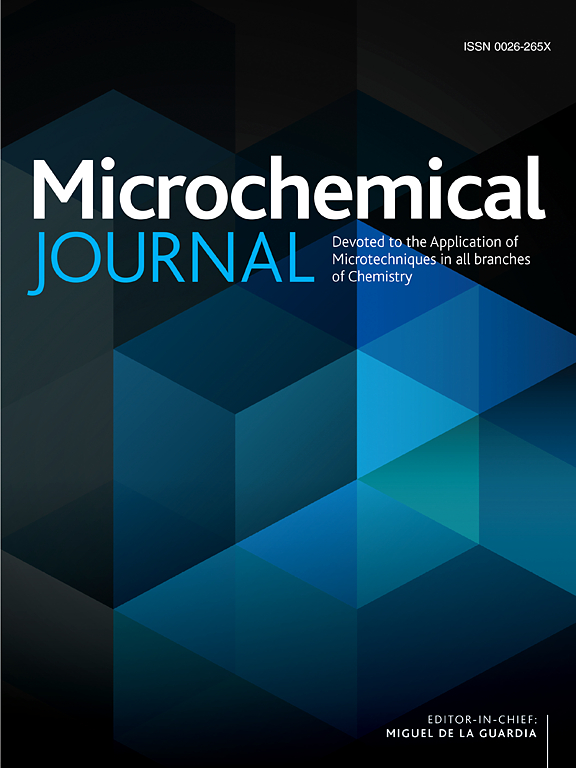Ratiometric electrochemical direct sensing of ciprofloxacin antibiotic via electroless plating of silver on graphynes
IF 4.9
2区 化学
Q1 CHEMISTRY, ANALYTICAL
引用次数: 0
Abstract
The abuse of ciprofloxacin (CIP) antibiotic has aroused severe harm to the humans, thus achieving its sensitive and reliable detection is very important. Herein, by using a rising-star material graphynes (GDY) as the substrate, we firstly revealed Ag+ can be self-reduced via simple electroless plating process to form tiny silver (Ag0) nanoparticles (Ag NPs) and obtained a novel Ag@GDY nanohybrid. For this nanohybrid, the resulted Ag NPs can not only improve the conductivity and resolve the aggregation of GDY, but also can be used as an internal reference to construct a ratiometric electrochemical sensor; meanwhile, GDY can provide the affinity ability to CIP molecules via π-π interaction, and the band theory analysis also demonstrated the Ag@GDY nanohybrid could exhibit the synthetical catalysis advantages from Ag NPs and GDY, showing enhanced greatly catalytical activity compared to the pure GDY. On the basic of these comprehensive superiorities, a sensitive ratiometric electrochemical direct sensing platform for CIP was then developed for the first time by using Ag@GDY modified electrode, which was confirmed to be linear with the CIP concentrations from 0.09 to 5.0 μM via adopting the current ratio between CIP and Ag0 as the read-out signal. Under the optimized conditions, the detection limit for CIP is as low as 23.0 nM in this work, and the constructed Ag@GDY sensor for CIP detection in the real samples was also confirmed, which thus showed important potential applications.

石墨烯化学镀银对环丙沙星抗生素的比例电化学直接传感
环丙沙星(CIP)类抗生素的滥用已对人体造成严重危害,实现对其敏感、可靠的检测具有十分重要的意义。本文以新兴材料石墨炔(GDY)为衬底,首次揭示了Ag+可以通过简单的化学镀工艺自还原形成微小的银(Ag0)纳米粒子(Ag NPs),并获得了一种新型Ag@GDY纳米杂化物。对于这种纳米杂化物,所得到的Ag NPs不仅可以提高电导率,解决GDY的聚集问题,而且可以作为构建比例电化学传感器的内部参考;同时,GDY可以通过π-π相互作用提供对CIP分子的亲和能力,带理论分析也表明Ag@GDY纳米杂化物具有Ag NPs和GDY的合成催化优势,与纯GDY相比,其催化活性大大增强。在上述综合优势的基础上,利用Ag@GDY修饰电极首次开发了一个灵敏的比例电化学直接传感平台,并以CIP与Ag0之间的电流比作为读出信号,证实了该平台与CIP浓度在0.09 ~ 5.0 μM范围内呈线性关系。在优化的条件下,本工作对CIP的检出限低至23.0 nM,构建的用于实际样品中CIP检测的Ag@GDY传感器也得到了证实,具有重要的潜在应用价值。
本文章由计算机程序翻译,如有差异,请以英文原文为准。
求助全文
约1分钟内获得全文
求助全文
来源期刊

Microchemical Journal
化学-分析化学
CiteScore
8.70
自引率
8.30%
发文量
1131
审稿时长
1.9 months
期刊介绍:
The Microchemical Journal is a peer reviewed journal devoted to all aspects and phases of analytical chemistry and chemical analysis. The Microchemical Journal publishes articles which are at the forefront of modern analytical chemistry and cover innovations in the techniques to the finest possible limits. This includes fundamental aspects, instrumentation, new developments, innovative and novel methods and applications including environmental and clinical field.
Traditional classical analytical methods such as spectrophotometry and titrimetry as well as established instrumentation methods such as flame and graphite furnace atomic absorption spectrometry, gas chromatography, and modified glassy or carbon electrode electrochemical methods will be considered, provided they show significant improvements and novelty compared to the established methods.
 求助内容:
求助内容: 应助结果提醒方式:
应助结果提醒方式:


